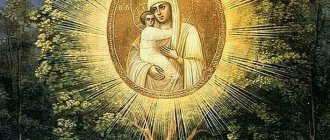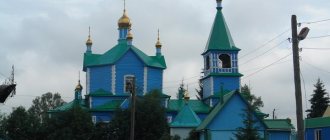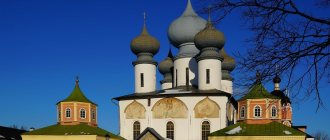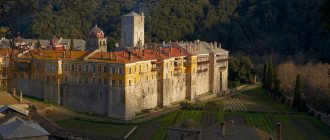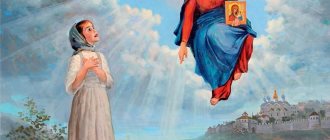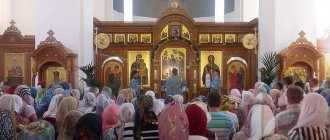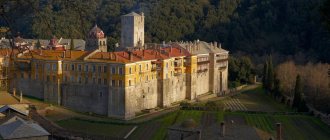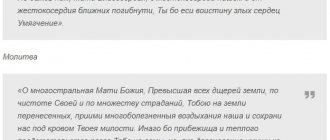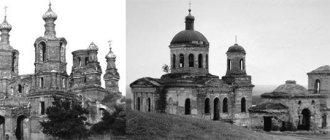Hard tests
The power of the Bolsheviks was a test for many people, especially believers.
The Red Army soldiers plundered and closed churches, destroyed everything that was connected with religion. The Trinity-Skanov Monastery did not escape this fate, and with it the miraculous image of the Mother of God. In the 30s of the twentieth century, the new government closed the monastery, organizing a poultry farm in it. The caves, which were once inhabited by hermit monks, were blown up. There are only 600 meters left from the two-kilometer caves. All the furnishings were looted, and the Trubchevskaya Icon of the Mother of God was turned into a stand for museum exhibits in the regional local history museum of A.I. Kuprina. All the precious decoration was removed from the icon. And, of course, no one cared about the safety of the miraculous canvas; they even placed indoor flowers on the holy image. In 1975, they made another inventory in the museum and wrote that the Trubchevskaya Icon of the Mother of God was lost. But 18 years later, thanks to the search for missing museum values, the image of the Virgin Mary, painted in Trubchevsk, was found in the storerooms of the same museum.
Song 5
Irmos: Enlightening with the radiance of Thy Coming, O Christ, and illuminating with Thy Cross the ends of the world, enlighten the hearts with the light of Thy God-Understanding of those who Orthodoxy sing Thee.
Most Holy Theotokos, save us.
We recognize Your immeasurable mercy, O Lady, in the glorious miracles that happen from Your icon. For this reason, we honor her with love and reverence, and slavishly before her we cry out to You: Rejoice, joy to the Author of ours and the Intercessor of our salvation, Mary of Grace.
Most Holy Theotokos, save us.
Let us approach, faithfully, with love the miraculous image of the Ever-Virgin and worship Him with reverence, for in it the All-Good Lady manifests the power of miracles and saves everything, with undoubted faith those who worship Her most pure face likeness.
Glory:
Be persistent, O Lady, with Thy help and intercession for us, Thy humble servant, and just as Thy chosen one, the Reverend Anthony, Thou hast shown Thy mercy, to this and to us, who sing Thee in His fatherland, show Thy uncountable mercy, in our life and at our death constantly interceding.
And now:
Your sung miracles, which were in the city of Lyubechi, the Virgin Mary, amaze people's thoughts, and the faithful are drawn to worship your miraculous image, in which you gloriously showed the power of miracles, Lady, for our salvation and affirmation.
Description of the icon
The icon is round oval in shape, carved on jasper, and measuring 5.7x4.1x0.8 cm, similar to a cameo or breastplate icon. An image of the Mother of God and Child in low relief on an oval jasper plate with a slight narrowing towards the top; the icon's turnover is smooth. The shades of jasper itself are green and dark red. Mixing these colors optically creates the impression of an ocher color. The jasper icon underwent restoration: it was split into pieces and was glued together with wax. Previously, the icon had the inscription: “The most honorable Cherub and the most glorious without comparison Seraphim, who gave birth to God the Word without corruption” (not preserved). The Mother of God in the icon is represented with the Infant Christ on her right hand, holding her left hand to her chest, Her uncovered head is bowed strongly to the right and touches the head of the Son. The baby in a short chiton, which leaves his bent knees open, is depicted clinging to the Mother, his right hand is directed towards Her, his head is thrown back. The halos are elliptical in shape; the maforia of the Mother of God has dynamic folds; Greek letters, traditional for this type of icons, are distinguishable in the designation of Their names.
Among the Belarusian miraculous icons, the Zhirovichi icon is the only one made in flat relief on stone. The Zhirovichi icon belongs to the iconographic type of Eleus (Tenderness), reflecting the idea of the Mother of God's intercession. The iconography of Tenderness developed in ancient Coptic art of Egypt.
In literature and oral testimony
Stand in the monastery temple
The first known written retelling of the legend of the Zhirovitsky Icon is written in 1622 by the Zhirovitsky monk Theodosius in the Old Belarusian language, “History or the story of noble people, worthy of the faith, about the miraculous image of the Most Holy Virgin Mary of Zhirovitsky in the Slonim Povet, completely clever, briefly written and collected with considerable effort and diligence I despise the much sinful Father Fedosy.”
In 1622, the book “History, or stories of people worthy of trust about the miraculous icon of the Most Pure Virgin Mary of Zhirovichi” was published in Vilna. The book was republished in Vilna in 1625, 1628, in Suprasl in 1629, 1653, 1714. In 1639, “The Story of the Miracle-Working Icon of the Zhirovichi Virgin Mary” was published. In 1644, King Vladislav IV and his wife Cecilia Renata spent two days in Zhirovichi. In the same year, a new book about the Zhirovichi icon, A. Dubovich’s “Connection of the Earth’s Planets,” was published. In 1719, a book by priest Ignatius Volodko “The Most Holy Virgin of Zhirovichi” was published in Rome, and in 1729 a book by canon Isidore Nardi “Historical news of a copy of the icon of the Virgin of Zhirovichi” was published. In the second half of the 18th century, several more books about the icon were published. Currently, the bibliography is very extensive.
There are many written and oral testimonies of miracles and healings performed. At the site of the appearance of the icon, as well as next to it, there are springs considered miraculous.
History of the Pochaev Icon
The Pochaev Icon of the Mother of God is one of the revered images in Orthodoxy. It took its name from the place of glorification - the city of Pochaev (Ternopil region, Ukraine).
Pochaev Icon of the Mother of God
The time when the Pochaev Icon of the Mother of God was painted has not been precisely established. The first information about it appears in 1559. The Greek Metropolitan Neophytos (later Patriarch of Constantinople) passed through the Volyn land. He stayed at the estate of Anna Goiskaya. As a token of gratitude for the hospitality provided, he gave her this icon. From prayer before the miraculous image of the Mother of God, Anna’s brother Philip, blind from birth, regained his sight. The icon was taken in a solemn religious procession to the Pochaev Monastery. The monastery was founded by monks of the Kiev Pechersk Lavra who fled from the Tatars back in 1240.
The further fate of the Pochaev Icon of the Mother of God is closely intertwined with the fate of the Pochaev Monastery. In 1721, the monastery was captured by the Uniates (Greek Catholics - former Orthodox Christians who recognized the authority of the Pope). But even at this time, many healings occurred from the miraculous image. All of them were carefully recorded in the monastery chronicle. The addition of crowns over the heads of the Mother of God and the Child of God dates back to this time.
Since 1832, the monastery was again returned to the fold of the Orthodox Church. Currently it has the status of a Lavra. The icon is kept in the Assumption Cathedral, and an akathist is read before it every day. After the reading, the miraculous image is lowered with the help of silk ribbons for veneration by Christians.
The celebration of the Pochaev Icon of the Mother of God takes place several times a year. September 21 (new style) in memory of the transfer of the miraculous icon to the Pochaev Monastery. August 5 (new style) in memory of the deliverance of the Pochaev Monastery from the Turkish attack (1675).
Christian shrine
The Zhirovitsk icon is revered in two Christian churches that are present on the territory of Belarus: Catholic and Orthodox. The brotherhood of the monastery fought against Uniatism for many years. The unification of several church movements with the Catholics was an imaginary unity, in which the external side of Orthodox rituals was preserved, Catholic dogmas and the primacy of the Pope were accepted. Uniatism began to operate in 1596. It was imposed on the residents of Belarus and Ukraine. But Russian Orthodoxy never accepted the union. Uniatism had political overtones. Therefore, the heads of some countries forcibly took away Orthodox churches, allowing the Uniates to hold services in them.
We recommend studying Psalm 8
The monastery in Zhirovichi in the 17th century, after numerous intrigues, came into the power of the Uniates. The monastery church was empty at that time because people did not want to come to it. During this period, a copy of the Zhirovitsk Icon was found in Rome. The Catholics were enlightened by the Mother of God, after which they began to venerate her image. The list from the Roman fresco was sent to Zhirovichi. This is how two very revered images ended up in the monastery.
Photo 2. The Zhirovitsky image is very revered by all Orthodox people.
After some time, the monks asked the Pope to crown the Zhirovitsky icon. With his blessing, they made a golden crown, which was placed on the icon on the most solemn occasions with a huge number of believers and pilgrims. It became a symbol of the miracles that the icon of grace gave.
The monastery was returned to the Orthodox Church in 1839. And with it the miraculous Orthodox shrine returned. In those distant times, the monastery in Zhirovichi became the first in which Orthodox services were resumed after the dominance of the Uniate movement.
During the First World War, the miraculous Zhirovitsky image was transported to Moscow for the worship of believers. Since the twenties of the last century, the icon has been located within the walls of the Zhirovitsky monastery in the Assumption Cathedral. By the way, Catholics and Uniates still come to venerate the image
It is very important to ask the Mother of God for help sincerely and not to forget about gratitude
There are currently several healing springs within the monastery walls. People wash themselves with water from them and drink to get rid of diseases. By the way, particles of the stone on which the icon was found after a terrible fire are also considered a shrine.
Monastery under Uniate rule
In 1605, Zhirovichi again changed its owner; it became the Lithuanian nobleman Ivan Meleshko, who transferred the monastery located on the territory of his possessions to the jurisdiction of the Uniate Church, which, as is known, retained part of the Orthodox rites, but was subordinate to the Vatican. This is how the Orthodox icon of the Zhirovitsk Mother of God found itself under the shadow of the Roman pontiff.
This small-sized image of the Blessed Virgin brought the monastery wide fame due to the miracles revealed through it. For example, when in June 1660, the Lithuanian hetman Pavel Sapieha managed to inflict a significant blow on the Russian troops near the village of Polonka, then, by all accounts, his success was served by the prayer to the Zhirovitsky Icon of the Mother of God, which the governor read publicly before the start of the battle.
True, they tried not to remember that already in the autumn of the same year the Pskov boyar Prince Khovansky gave him a good beating, the main thing is that hundreds of pilgrims went to venerate the miraculous icon, not forgetting to replenish the monastery treasury.
Story
The icon appeared in 1470 on the territory of Belarus, in a town called Zhirovichi. One day the shepherdesses discovered her in a deep forest in the foliage of a pear tree. The peasants took off the image and took it to their owner. The landowner, of course, decided to hide the icon at home. But the very next day, Prince Soltan discovered that the image had disappeared from the box. Surprisingly, he found himself back on a tree in the wilderness. The prince saw an omen in this event, so he ordered a temple to be built on the very spot where the icon was discovered. And a few years later a misfortune happened. The temple completely burned down, but the face of the Mother of God miraculously remained intact. This incident shocked people. The image was not found after the fire. He appeared to people after some time. Village children were returning from school and found an icon on a stone with a burning candle. A new stone temple was erected on this site, which marked the beginning of the monastery. Probably the first monks were local residents. The first monastic community around the temple appeared in the 16th century. It was later turned into a monastery. By that time, the Soltanov family was already greatly impoverished, but continued to own local lands. Yakov, one of his representatives, even wanted to build another stone temple on the monastery territory. But he did not have time to realize his plans, since in the middle of the century the lands were given to the banker Isaac Mikhalevich for debts. The territories were later able to be purchased by the heirs of Jacob, who converted to Catholicism.
Figure Photo 1. The Zhirovitsk icon is carved on a jasper stone.
After its re-acquisition, the image began to exude miracles, rumors of which have reached our time. The Zhirovitsk icon is venerated every year on May 20.
Chimeevskaya Icon of the Mother of God: meaning, what it helps with
Although the Chimeevskaya Icon of the Mother of God is considered a locally revered image, its fame has spread far beyond the borders of Siberia and even Russia - this is evidenced by numerous pilgrimages not only from our country, but also from abroad. The story of the discovery of the miraculous Chimeevskaya icon is also connected with a miracle.
History of the icon
This miracle happened in the first half of the 18th century. Residents of the village of Chimeeva saw some kind of large dark board carried by the stormy waters of the Niyap River. When the board fell into the whirlpool, it tilted, and those present were literally scorched by the gaze of the incredibly expressive eyes of the Virgin Mary.
The icon was placed in the Chimeevskaya Church, from which it received its name. What kind of disasters have befallen this amazing icon, and what kind of miracles it has not shown! In 1770, the church burned down, but the Chimeevskaya Icon of the Mother of God was found unharmed in the ashes, with only a slightly burnt face (the trace of it is still visible today).
In Soviet times, the icon showed another miracle. When in 1937 the Chimeevskaya Church was completely destroyed, throwing off the bells and taking out all the icons, the Chimeevskaya Icon of the Mother of God could not be moved from its place, so it remained in the boarded-up church. The news of this miracle spread widely throughout the area. Pilgrims came from far and wide to pray with the parishioners in front of the church doors.
Only ten years later the temple was returned to the believers, and it was discovered that the miraculous icon was safe and sound.
She helped so many people that her fame spread throughout the country, and the flow of pilgrims has not dried up to this day.
In 2002, the Chimeevskaya Icon of the Mother of God was transferred to the Holy Kazan Chimeevsky Monastery, from where its exact copy is taken to other dioceses. The icon itself is considered too rare and valuable, since this image was practically never repeated in icon painting. This is its enormous significance both for believers and for Russian iconography.
The meaning of the Chimeevskaya icon
The Chimeevskaya icon is a canonical version of the image of the Kazan Mother of God, so sometimes you can find its double name: the Chimeevskaya Icon of the Kazan Mother of God. According to its iconographic type, it is classified as Hodegetria (Guide) - one of the most ancient images of the Mother of God. According to legend, Saint Luke himself was the first to paint such an image.
The Mother of God is depicted with her head bowed towards the Baby Jesus, while He stands at full height, making a blessing gesture with his right hand. The most important difference of the Chimeevskaya icon is the absolutely stunning eyes of the Mother of God, unusually large and as if piercing right through. Although the icon itself darkened with time, the eyes of the Mother of God retained their brightness.
We advise you to study Prayers to Cyril and Methodius
The icon is painted on a massive board measuring 108x89 cm. Currently, instead of the previous silver-plated frame, a frame has been made for it from crosses, rings and chains, with which pilgrims hung the miraculous icon so that the face was almost invisible - clear evidence that the prayer to the Chimeevskaya icon The Mother of God helps in solving vital problems.
How does prayer to the Chimeevskaya Icon of the Mother of God help?
Many healings have been witnessed after praying in front of this icon; many women have found the happiness of motherhood after this. But not only the body, but also the soul, prayer to the Chimeevskaya Icon of the Mother of God brings healing: it helps strengthen love and family relationships, protects against temptations, relieves bitterness and mistrust, fears and doubts, and fills the soul with peace.
Holiday on July 21 and November 4.
Prayer to the Chimeevskaya Icon of the Mother of God
O Most Holy Lady Lady Theotokos! With fear, faith and love, falling before Thy honorable icon, we pray to Thee: do not turn Thy face away from those who come running to You, beseech, merciful Mother, Thy Son and our God, the Lord Jesus Christ, to keep our country peaceful, and to establish the Russian state in piety, may she preserve her Holy Church unshakably from unbelief, heresies and schism.
There are no imams of any other help, no imams of other hope, except You, Most Pure Virgin: You are the All-Powerful Helper and Intercessor of Christians.
Deliver all who pray to You with faith from the falls of sin, from the slander of evil people, from all temptations, sorrows, troubles and from vain death; Grant us the spirit of contrition, humility of heart, purity of thoughts, correction of sinful lives and the remission of sins, so that we all, praising Thy greatness with gratitude, may be worthy of the Heavenly Kingdom and there with all the saints we will glorify the most honorable and magnificent name of the Father and the Son and the Holy Spirit. Amen.
(1 5.00 out of 5) Loading...
Song 1
Irmos: Your victorious right hand is gloriously glorified in the fortress: that Bo, Immortal, like the almighty erased the enemy, re-made the path of depth for the Israelis.
Chorus:
Most Holy Theotokos, save us.
Let us purify our senses and see in the unapproachable Light the Mother of Light, in Her miraculous icon, shining with glorious miracles and illuminating our souls, let us rejoice, calling: Rejoice, Mother of the Lord.
Most Holy Theotokos, save us.
Let the heavens rejoice, and let the earth rejoice, beholding the great miracles of the Ever-Virgin icon, and let the city of Lyubech celebrate the day of the appearance of the miraculous icon of the Mother of God, honoring this as an enclosure wall.
Glory:
You have broken the limit of mortification, O Lady, having given birth to Eternal Life - Christ, Who You carried in Your hand like a Child, just as we see You in Your holy icon, the All-Immaculate Virgin.
And now:
You who gave birth to the Resurrection of the Dead, the Author and Giver of Life, O God-Blessed One, hear the joy of all generations of Christians, and with Your holy icon you comfort the faithful and strive to cry out to You: Hail, All-Blessed Mary.
Miracles performed through the Pimenovskaya Icon of the Mother of God
Almost immediately upon arrival on Russian soil, Pimenovskaya Hodegetria became a source of miraculous healings. All of them were associated with myrrh-streaming, a unique phenomenon that results in the release of fragrant oil on the surface of the icon.
The very first case of myrrh-streaming of the Pimenovskaya icon was recorded in 1407 in the above-mentioned “Book of Degree”. A certain Tyutrum, a “glorious merchant,” persuaded the servants of the cathedral to bring this image of the Mother of God to his house and perform a prayer service. During the service, the miracle of myrrh flowing occurred.
Another written source, in which there is a mention of the expiration of the chrism from the Pimenovskaya Mother of God, is stored in the Department of Rare Books and Manuscripts of the Moscow State University Scientific Library. It is called “The Legend” and was compiled in the 18th century by the guard of the Annunciation Church S. Mokhovikov. The compiler colorfully talks about how “the ointment came from her head,” meaning Pimenovskaya Hodegetria.
The fragrant myrrh collected from the icon has been used at all times to anoint sick and suffering pilgrims. According to legend, after anointing and praying before the icon of the Pimenovskaya Mother of God, people were healed of various physical and spiritual ailments. Probably, this special grace exuded was one of the reasons for the transfer of the image to the rebuilt Peace Chamber.
Description of the unique icon
Unlike the icons we are used to, the Zhirovitsky image is an oval composition in the form of a relief made on jasper. Its dimensions are very small - 5.7 x 4.1 x 0.8 cm, and in appearance it resembles a breastplate icon or cameo. The reverse side of the icon is smooth. The jasper from which it is made has a natural combination of dark red and green colors, visually creating an ocher hue.
The Most Holy Theotokos is depicted holding Her Eternal Child on her right hand, while her left hand is pressed to her chest. The uncovered head of the Queen of Heaven is tilted towards the Son clinging to her and lightly touches Him. The Baby Jesus is dressed in a short tunic that leaves His knees exposed. The heads of the Mother and Son are crowned. On the sides, Greek letters are visible, traditional for this type of icons, and denoting their names.
The icon of the Zhirovitsk Mother of God, the description given above, belongs to the iconographic type called “Eleus” - Tenderness. This type of Mother of God icons is very ancient, and appeared in Egypt in the early Christian period, when the so-called Coptic art flourished.
Prayers before the image
People turn to the Zhirovitskaya icon with the image of the Mother of God in prayer with a variety of requests. They pray and offer:
- requests for healing;
- prayers for strengthening faith;
- about help in finding the right path;
- about getting rid of doubts.
There are many cases in which prayer in front of this icon helped people and again taught them to believe in miracles and enjoy every moment of life.
- The fragments of stones taken from the monastery saved the life of a woman and her newborn baby.
- Thanks to the fact that relatives prayed for the woman’s health in front of the shrine, she fully recovered from consumption.
- One day a boy was healed while singing a funeral chant. All thanks to the fact that the mother fervently read the prayer before the face of the Mother of God.
- The icon helped the man get rid of a serious illness, due to which he could not move and lost almost all his physical strength.
- One elderly woman was completely cured of rheumatism due to the fact that her joints were anointed with oil that burned in a lamp standing in front of the holy face.
- A poor woman's son was diagnosed with a brain cyst. She prayed in front of the shrine and even brought the boy to that same temple several times. After the first visit, his health improved noticeably, and after 5 visits, doctors examined him and found no malignancy.
Song 3
Irmos: Alone, knowing the weakness of the human being and mercifully not imagining it, girdling me with strength from on high, crying out to You, Holy One, animated in the temple, Your ineffable glory, O Lover of Mankind.
Most Holy Theotokos, save us.
Now the people of the city of Lyubech are filled with joy at the appearance of Your miraculous icon, the Mother of God, and brightly celebrate the feast of Her appearance, as truly the triumph of Orthodoxy and the disgrace of heresies by Your power, Lady.
Most Holy Theotokos, save us.
See, O Pure One, the Orthodox cathedrals for the veneration of Your miraculous image coming. See us, sinners, who fall with love into Your multi-healing image, ask for forgiveness of sins and correction of life, and do not deprive us of Your Motherly intercession, All-Immaculate One.
Glory:
An unenviable stream of miracles flows from Thy pure icon, Virgin Mary, from which they receive healing and consolation, praying for the warmth of evil, deliverance and Thy great mercy, Most Pure One.
And now:
With all our souls and humble thoughts we glorify Your miracles, O Lady, who with love stands before Your miraculous icon, in which You have given us the guarantee of Your favor, O Bride of God. Likewise, be persistent from us with Your mercy.
Lord have mercy ( three times
).
Glory, and now:
How the Zhirovitsk Icon appeared
A legend full of miracles and amazing events is associated with this image. The discovery dates back to 1470, when his shepherds were walking on the lands of the Lithuanian treasurer Alexander Soltan. They saw a bright light in the forest that came from a pear tree.
Having approached and waited a little, the shepherds were able to see a miraculous image that appeared on a tree and was made on jasper, the size of a small palm. As a result, the Zhirovitsky icon ended up with Soltan himself, who did not pay much attention to this image and put it in a casket. Only after the icon disappeared and appeared again on a tree did he decide to build a temple there to worship the miraculous image.
The temple was created and people almost immediately began to find out how the Zhirovitsk Icon of the Mother of God helps, turning to the new relic. Various healings were recorded and even the resurrection of a girl who was taken to the icon for blessing, but was not taken due to illness.
We advise you to study the Icon of the Ladder
At the beginning of the 16th century, the first temple, which was built where there was a pear tree, burned down and the icon was considered lost, but after some time a second discovery occurred when, in fact, a burning candle and an icon were discovered on the ashes. The Yavlensky Temple was built there, which still exists today. However, now the Zhirovichi Icon of the Mother of God is kept in the Assumption Church of the Blessed Virgin Mary, which was built in the early 17th century from stone.
This is interesting: Icon of the Most Holy Theotokos “Tabynskaya”
Finding young shepherdesses
The history of the icon is as unusual as its appearance. They say (and people, as you know, won’t say it in vain) that in 1470 this icon was first revealed in the Grodno region not far from the village of Zhirovichi, the name of which, as you might guess, gave it its name. It so happened that local children were herding cattle in a forest that belonged to a wealthy nobleman - Lithuanian by birth, but Orthodox by faith. His name was Alexander Soltan.
Suddenly (the most interesting thing in stories usually always begins with this word), they saw a bright light emanating from the crown of a pear tree growing on the edge of the tree. Having overcome their fear, the shepherdesses came closer, and among the foliage they saw a small icon, from which rays were shining in all directions. Holding their breath, the children took the wonderful find from the tree and rushed headlong with it to their owner. Needless to say, this was the same icon of the Zhirovitsk Mother of God - the Blagozdratnitsa, as it was later called for the numerous miracles of healing revealed through it.
Healings in front of the shrine
Christians who believe in the Lord God and the Most Pure Virgin Mary often call the Zhirovitsky icon healing. In the history of the holy image, there are hundreds of miraculous acts and healings inexplicable to science.
A woman dying during difficult childbirth was given a piece of stone, specially brought from the Assumption Zhirovitsky Monastery. And a miracle happened: the woman in labor not only survived, but also gave birth to a completely healthy baby.
Desperate to save a young woman dying of consumption, the relatives fell to their knees before the Zhivoritskaya icon and prayed to the Mother of God. The sincerity of the prayer was heard - the patient was healed of a serious illness.
The bibliography of the holy image records many cases of miraculous healings from migraines, memory loss and autoimmune diseases.
During World War II, fascist troops entered the Belarusian village of Zhirovichi. The Nazis placed their ammunition in the Temple of God. One day the Blessed Virgin Mary appeared to them. Frightened by what they saw, the Germans wanted to blow up the temple with ammunition, but all their attempts were unsuccessful. The walls of the temple survived.
Soviet pilots said that, flying over the village of Zhirovichi, they did not see the monastery. There is an opinion that this is how the holy face protected the house of God from enemies.
Events of the 20th century
During the First World War, not only Grodno, but also the surrounding territories were engulfed in battles. To preserve the icon, it was temporarily transported to Moscow to the Intercession Cathedral. Later the image ended up in the town of Vidnoye. The icon was kept in Catherine's monastery for several years. She was returned to Zhirovichi in 1922. At that time, an anti-religious campaign was underway in the country. Therefore, the image was transported to its homeland in a jam jar. Only the salary could not be returned. But in the monastery the monks made a new one.

